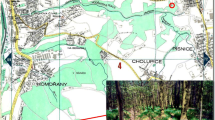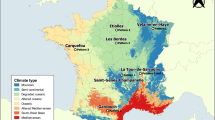Abstract
Wood ticks, Ixodes ricinus L., serve as vectors for various pathogens and are ubiquitous throughout Central Europe. Survival and development of I. ricinus depend on biotic and abiotic factors. We examined whether relative humidity (RH), air (T a ) and soil temperatures (T s ), or snow depth during November through February affect the questing activity of ticks during their subsequent season of activity. We related the number of host-seeking nymphs to meteorological parameters measured in close proximity at minutely intervals over the period of 6 years (2010–2015) in an urban park in Berlin. We defined thresholds at which associations appeared strongest. Although the annual variations in RH, T a , and snow depth were typical of the mid-latitudes, the questing activity of nymphs during their first peak of activity (March through July) varied among the 6 years more than threefold. The accumulated hours of RH below 77% in 2 m height during November through February affected the questing activity of nymphs during the following activity peak. In contrast to T a , accumulated hours of T s below −1 °C in 0.02 m depth or below −4 °C in 0.05 m depth during the preceding period significantly influenced the average number of nymphs questing during spring. Our observations suggest that RH, T s , and snow cover during the preceding months affect the questing activity of nymphal I. ricinus during their first peak of activity. Snow cover serves as an insulator between the atmosphere and soil, which not only stabilizes T s but also appears to protect ticks from exposure to frost and frequent temperature shifts.







Similar content being viewed by others
References
Berger KA, Ginsberg HS, Dugas KD, Hamel LH, Mather TN (2014a) Adverse moisture events predict seasonal abundance of Lyme disease vector ticks (Ixodes scapularis). Parasite Vector 7:181. doi:10.1186/1756-3305-7-181
Berger KA, Ginsberg HS, Gonzalez L, Mather TN (2014b) Relative humidity and activity patterns of Ixodes scapularis (Acari: Ixodidae). J Med Entomol 51:769–776
Burtis JC, Ostfeld RS, Yavitt JB, Fahey TJ (2016) The relationship between soil arthropods and the overwinter survival of Ixodes scapularis (Acari: Ixodidae) under manipulated snow cover. J Med Entomol 53:225–229
Daniel M, Honzakova E, Cerny V (1972) Overwintering of the tick Ixodes ricinus (L.) under conditions of a field experiment. Folia Parasit 19:305–314
Daniel M, Maly M, Danielova V, Kriz B, Nuttall P (2015) Abiotic predictors and annual seasonal dynamics of Ixodes ricinus, the major disease vector of Central Europe. Parasite Vector 8:478. doi:10.1186/s13071-015-1092-y
Dautel H (2010) Zecken und Temperatur. In: Aspöck H (ed) Krank durch Arthropoden. Denisia 30:149–169
Dautel H, Knülle W (1997) Cold hardiness, supercooling ability and causes of low-temperature mortality in the soft ticks, Argas reflexus, and the hard tick, Ixodes ricinus (Acari: Ixodoidea) from Central Europe. J Insect Physiol 43:843–854
Dusbabek F, Daniel M, Cerny V (1971) Stratification of engorged Ixodes ricinus larvae overwintering in soil. Folia Parasit 18:261–266
Groffman PM, Driscoll CT, Fahey TJ, Hardy JP, Fitzhugh RD, Tierney GL (2001) Colder soils in a warmer world: a snow manipulation study in a northern hardwood forest ecosystem. Biogeochemistry 56:135–150
Hardy JP, Groffman PM, Fitzhugh RD, Henry KS, Welman AT, Demers JD, Fahey TJ, Driscoll CT, Tierney GL, Nolan S (2001) Snow depth manipulation and its influence on soil frost and water dynamics in a northern hardwood forest. Biogeochemistry 56:151–174
Hayes LE, Scott JA, Stafford KC (2015) Influences of weather on Ixodes scapularis nymphal densities at long-term study sites in Connecticut. Ticks Tick-borne Dis 6:258–266
Herrmann C, Gern L (2013) Survival of Ixodes ricinus (Acari: Ixodidae) nymphs under cold conditions is negatively influenced by frequent temperature variations. Ticks Tick-borne Dis 4:445–451
Knülle W, Rudolph D (1982) Humidity relationships and water balance of ticks. In: Obenchain FD, Galun R (eds) Physiology of ticks. Pergammon Press, Oxford, pp 43–70
Lees AD (1946) The water balance in Ixodes ricinus L. and certain other species of ticks. Parasitology 37:1–20
Lohr B, Müller I, Mai M, Norris DE, Schöffski O, Hunfeld KP (2015) Epidemiology and cost of hospital care for Lyme borreliosis in Germany: lessons from a health care utilization database analysis. Ticks Tick-borne Dis 6:56–62
Luterbacher J, Dietrich D, Xoplaki E, Grosjean M, Wanner H (2004) European seasonal and annual temperature variability, trends and extremes since 1500. Science 303:1499–1503. doi:10.1126/science.1093877
Müller I, Freitag MH, Poggensee G, Scharnetzky E, Straube E, Schorerner CH, Hlobil H, Hagedorn HJ, Stanek G, Schubert-Unkmeir A, Norris DE, Gensichen J, Hunfeld KP (2012) Evaluating frequency, diagnostic quality and cost of Lyme borreliosis testing in Germany: a retrospective model analysis. Clin Dev Immunol 2912:595427. doi:10.1155/2012/595427
R Core Development Team (2008) A language and environment for statistical computing. R Foundation for Statistical Computing, Vienna
Richter D, Matuschka F-R (2011) Differential risk for Lyme disease along hiking trail, Germany. Emerg Infect Dis 17:1704–1706
Rodgers SE, Zolnik CP, Mather TN (2007) Duration of exposure to suboptimal atmospheric moisture affects nymphal blacklegged tick survival. J Med Entomol 44:372–375
de Vries H, Lenderink G, van Meijgaard E (2014) Future snowfall in western and Central Europe projected with a high-resolution regional climate model ensemble. Geophys Res Lett 41:4294–4299
Acknowledgements
This study was conducted in the framework of “MILIEU – Man in Urban Agglomerations – the Influence of Climate and Environmental Issues” funded by the Excellence Initiative of the Deutsche Forschungsgemeinschaft (DFG). We thank Franz-Rainer Matuschka and Uwe Ulbrich for inspiring this study, Christina Kohn for collecting ticks during the first part of the study, and the Botanic Garden Berlin for permitting us to conduct the study on its premises.
Author information
Authors and Affiliations
Corresponding author
Ethics declarations
Conflict of interest
The authors declare that they have no conflict of interest.
Ethical approval
This article does not contain any studies with human participants or animals, other than ticks, performed by any of the authors.
Electronic supplementary material
ESM 1
(PDF 576 kb)
Rights and permissions
About this article
Cite this article
Vollack, K., Sodoudi, S., Névir, P. et al. Influence of meteorological parameters during the preceding fall and winter on the questing activity of nymphal Ixodes ricinus ticks. Int J Biometeorol 61, 1787–1795 (2017). https://doi.org/10.1007/s00484-017-1362-9
Received:
Revised:
Accepted:
Published:
Issue Date:
DOI: https://doi.org/10.1007/s00484-017-1362-9




